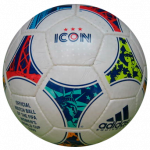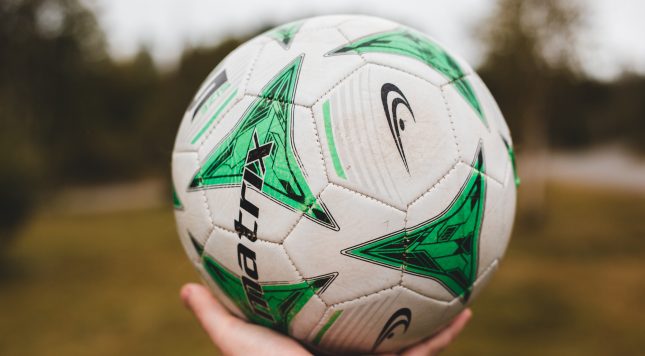Soccer balls have seen a lot of improvements and changes over the years since the very beginning. This article covers 10 balls that have been the most iconic soccer balls in the history of the game.
These are not necessarily the best soccer balls ever but the balls that got the most coverage or buzz from the media and fans of this game. Some of these balls mark certain improvements in the way that soccer balls are made.
1. First World Cup Ball
 There was no official ball during the first World Cup held in 1930. Argentina supplied the ball used in the 1st half – the Tiento, and Uruguay provided the ball used in the 2nd half – the T-Model.
There was no official ball during the first World Cup held in 1930. Argentina supplied the ball used in the 1st half – the Tiento, and Uruguay provided the ball used in the 2nd half – the T-Model.
An interesting fact is that Argentina won the first half by 2-1, but Uruguay ended up winning the game by 4-2, thereby becoming the first World Cup champions. The famous T-Model ball was distinctly larger and heavier than the Tiento supplied by Argentina.
2. Adidas Telstar
Adidas was the mastermind brand behind the black and white soccer ball design we all know and love. They called it the Telstar, and this ball made its debut in the 1970 World Cup.
Why the black and white design, though?
Well, before this, the soccer ball was all white. Since TVs were black and white, however, it proved difficult for viewers to keep track of the ball on the field. Adidas, therefore, added the black pentagonal panels to aid with TV viewing.
‘Telstar’ is a coined combination of two words: Television and Star.
3. Goodyear’s 1855 Ball
 Charles Goodyear invented vulcanized rubber in 1836. Then he went on to patent the rubber vulcanization process in 1844. 11 years later, in 1855, he designed and made the first vulcanized soccer ball.
Charles Goodyear invented vulcanized rubber in 1836. Then he went on to patent the rubber vulcanization process in 1844. 11 years later, in 1855, he designed and made the first vulcanized soccer ball.
This was a revolutionary moment for football because from then on, the rubber bladder in soccer balls replaced the pig and animal bladders used previously.
4. Mitre Ultimax
The Premier League was conceived in 1992, and the Mitre Ultimax was the first ball used in this top-flight league.
It goes down in history as the first synthetic ball used in English football, replacing the heavy and bulky leather balls used before this.
5. Adidas Teamgeist
 The Teamgeist was used in the 2006 World Cup Championships in Germany. This soccer ball is famous because it went against the norm and saw a reduction of panels, from 32 to 14.
The Teamgeist was used in the 2006 World Cup Championships in Germany. This soccer ball is famous because it went against the norm and saw a reduction of panels, from 32 to 14.
The 14-panel design resulted in fewer seams, thereby making the ball rounder and giving it a more consistent flight path. At the time of its release, this ball tested much better than any other ball in the world.
6. Adidas Jabulani
The most famous soccer ball ever made is probably the Jabulani used in the 2010 World Cup in South Africa.
Impressed by the performance of the Teamgeist, Adidas decided to push the boundaries even further. They reduced the number of panels even further, from 14 on the Teamgeist to 8 on the Jabulani.
The Jabulani brought so much controversy that NASA even had to conduct a study on the unpredictability of the ball.
7. Adidas 2008 Power Orange
 The Adidas Power Orange soccer ball was used during the 2007-08 UEFA Champions League season. This ball was a bright tangerine orange in color and had black stars with grey trim.
The Adidas Power Orange soccer ball was used during the 2007-08 UEFA Champions League season. This ball was a bright tangerine orange in color and had black stars with grey trim.
This striking design was intended for use in snowy conditions in case inclement weather struck Athens during the championships.
8. Nike Geo Merlin Vapor
Remember the 2002-03 Premier League season when Thierry Henry scored a ton of goals? Well, guess which ball was in use at the time?
During that season, the Nike Geo Merlin II produced 1,000 goals in the two years when it was in use.
9. Adidas ICON
 The 1999 Adidas ICON was the first ball specifically designed for a FIFA Women’s World Cup.
The 1999 Adidas ICON was the first ball specifically designed for a FIFA Women’s World Cup.
This ball featured colorful decorations set against the white backdrop, and it was praised highly by goalkeepers for having a very stable mid-air movement.
10. Adidas Roteiro
The Adidas Roteiro was made for the UEFA Euro 2004 championships. This ball goes is famous for being the first match-specific ball ever used.
Inscribed on the ball were the names of the playing teams, the name of the stadium, the date of the match, and the longitude and latitude of the pitch’s center spot.




















